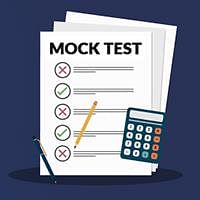CLAT Exam > CLAT Questions > Directions: Each question below is followed b...
Start Learning for Free
Directions: Each question below is followed by two arguments numbered I and II. You have to decide which of the arguments is a ‘strong’ argument and which is a ‘weak’ argument.
Give answer (a) : if only argument I is strong
Give answer (b) : if only argument II is strong.
Give answer (c) : if either argument I or II is strong.
Give answer (d) : if neither argument I nor II is strong.
Give answer (e) : if both arguments I and II are strong
Q.
Statement: Should the teenagers be denied access to the Internet?
Arguments:
I. Yes, most of the children, particularly the teenagers, are found indulging in accessing pornographic contents.
II. No, denying access to the Internet would mean denying access to a lot of useful information, instead the access may be controlled.
- a)if only argument I is strong
- b)if only argument II is strong.
- c)if either argument I or II is strong.
- d)if neither argument I nor II is strong.
- e)if both arguments I and II are strong
Correct answer is option 'E'. Can you explain this answer?
| FREE This question is part of | Download PDF Attempt this Test |
Most Upvoted Answer
Directions: Each question below is followed by two arguments numbered ...
Answer will be E because both the statements are true
Attention CLAT Students!
To make sure you are not studying endlessly, EduRev has designed CLAT study material, with Structured Courses, Videos, & Test Series. Plus get personalized analysis, doubt solving and improvement plans to achieve a great score in CLAT.

|
Explore Courses for CLAT exam
|

|
Similar CLAT Doubts
Directions: Each question below is followed by two arguments numbered I and II. You have to decide which of the arguments is a ‘strong’ argument and which is a ‘weak’ argument.Give answer (a) : if only argument I is strongGive answer (b) : if only argument II is strong.Give answer (c) : if either argument I or II is strong.Give answer (d) : if neither argument I nor II is strong.Give answer (e) : if both arguments I and II are strongQ.Statement: Should the teenagers be denied access to the Internet?Arguments:I. Yes, most of the children, particularly the teenagers, are found indulging in accessing pornographic contents.II. No, denying access to the Internet would mean denying access to a lot of useful information, instead the access may be controlled.a)if only argument I is strongb)if only argument II is strong.c)if either argument I or II is strong.d)if neither argument I nor II is strong.e)if both arguments I and II are strongCorrect answer is option 'E'. Can you explain this answer?
Question Description
Directions: Each question below is followed by two arguments numbered I and II. You have to decide which of the arguments is a ‘strong’ argument and which is a ‘weak’ argument.Give answer (a) : if only argument I is strongGive answer (b) : if only argument II is strong.Give answer (c) : if either argument I or II is strong.Give answer (d) : if neither argument I nor II is strong.Give answer (e) : if both arguments I and II are strongQ.Statement: Should the teenagers be denied access to the Internet?Arguments:I. Yes, most of the children, particularly the teenagers, are found indulging in accessing pornographic contents.II. No, denying access to the Internet would mean denying access to a lot of useful information, instead the access may be controlled.a)if only argument I is strongb)if only argument II is strong.c)if either argument I or II is strong.d)if neither argument I nor II is strong.e)if both arguments I and II are strongCorrect answer is option 'E'. Can you explain this answer? for CLAT 2024 is part of CLAT preparation. The Question and answers have been prepared according to the CLAT exam syllabus. Information about Directions: Each question below is followed by two arguments numbered I and II. You have to decide which of the arguments is a ‘strong’ argument and which is a ‘weak’ argument.Give answer (a) : if only argument I is strongGive answer (b) : if only argument II is strong.Give answer (c) : if either argument I or II is strong.Give answer (d) : if neither argument I nor II is strong.Give answer (e) : if both arguments I and II are strongQ.Statement: Should the teenagers be denied access to the Internet?Arguments:I. Yes, most of the children, particularly the teenagers, are found indulging in accessing pornographic contents.II. No, denying access to the Internet would mean denying access to a lot of useful information, instead the access may be controlled.a)if only argument I is strongb)if only argument II is strong.c)if either argument I or II is strong.d)if neither argument I nor II is strong.e)if both arguments I and II are strongCorrect answer is option 'E'. Can you explain this answer? covers all topics & solutions for CLAT 2024 Exam. Find important definitions, questions, meanings, examples, exercises and tests below for Directions: Each question below is followed by two arguments numbered I and II. You have to decide which of the arguments is a ‘strong’ argument and which is a ‘weak’ argument.Give answer (a) : if only argument I is strongGive answer (b) : if only argument II is strong.Give answer (c) : if either argument I or II is strong.Give answer (d) : if neither argument I nor II is strong.Give answer (e) : if both arguments I and II are strongQ.Statement: Should the teenagers be denied access to the Internet?Arguments:I. Yes, most of the children, particularly the teenagers, are found indulging in accessing pornographic contents.II. No, denying access to the Internet would mean denying access to a lot of useful information, instead the access may be controlled.a)if only argument I is strongb)if only argument II is strong.c)if either argument I or II is strong.d)if neither argument I nor II is strong.e)if both arguments I and II are strongCorrect answer is option 'E'. Can you explain this answer?.
Directions: Each question below is followed by two arguments numbered I and II. You have to decide which of the arguments is a ‘strong’ argument and which is a ‘weak’ argument.Give answer (a) : if only argument I is strongGive answer (b) : if only argument II is strong.Give answer (c) : if either argument I or II is strong.Give answer (d) : if neither argument I nor II is strong.Give answer (e) : if both arguments I and II are strongQ.Statement: Should the teenagers be denied access to the Internet?Arguments:I. Yes, most of the children, particularly the teenagers, are found indulging in accessing pornographic contents.II. No, denying access to the Internet would mean denying access to a lot of useful information, instead the access may be controlled.a)if only argument I is strongb)if only argument II is strong.c)if either argument I or II is strong.d)if neither argument I nor II is strong.e)if both arguments I and II are strongCorrect answer is option 'E'. Can you explain this answer? for CLAT 2024 is part of CLAT preparation. The Question and answers have been prepared according to the CLAT exam syllabus. Information about Directions: Each question below is followed by two arguments numbered I and II. You have to decide which of the arguments is a ‘strong’ argument and which is a ‘weak’ argument.Give answer (a) : if only argument I is strongGive answer (b) : if only argument II is strong.Give answer (c) : if either argument I or II is strong.Give answer (d) : if neither argument I nor II is strong.Give answer (e) : if both arguments I and II are strongQ.Statement: Should the teenagers be denied access to the Internet?Arguments:I. Yes, most of the children, particularly the teenagers, are found indulging in accessing pornographic contents.II. No, denying access to the Internet would mean denying access to a lot of useful information, instead the access may be controlled.a)if only argument I is strongb)if only argument II is strong.c)if either argument I or II is strong.d)if neither argument I nor II is strong.e)if both arguments I and II are strongCorrect answer is option 'E'. Can you explain this answer? covers all topics & solutions for CLAT 2024 Exam. Find important definitions, questions, meanings, examples, exercises and tests below for Directions: Each question below is followed by two arguments numbered I and II. You have to decide which of the arguments is a ‘strong’ argument and which is a ‘weak’ argument.Give answer (a) : if only argument I is strongGive answer (b) : if only argument II is strong.Give answer (c) : if either argument I or II is strong.Give answer (d) : if neither argument I nor II is strong.Give answer (e) : if both arguments I and II are strongQ.Statement: Should the teenagers be denied access to the Internet?Arguments:I. Yes, most of the children, particularly the teenagers, are found indulging in accessing pornographic contents.II. No, denying access to the Internet would mean denying access to a lot of useful information, instead the access may be controlled.a)if only argument I is strongb)if only argument II is strong.c)if either argument I or II is strong.d)if neither argument I nor II is strong.e)if both arguments I and II are strongCorrect answer is option 'E'. Can you explain this answer?.
Solutions for Directions: Each question below is followed by two arguments numbered I and II. You have to decide which of the arguments is a ‘strong’ argument and which is a ‘weak’ argument.Give answer (a) : if only argument I is strongGive answer (b) : if only argument II is strong.Give answer (c) : if either argument I or II is strong.Give answer (d) : if neither argument I nor II is strong.Give answer (e) : if both arguments I and II are strongQ.Statement: Should the teenagers be denied access to the Internet?Arguments:I. Yes, most of the children, particularly the teenagers, are found indulging in accessing pornographic contents.II. No, denying access to the Internet would mean denying access to a lot of useful information, instead the access may be controlled.a)if only argument I is strongb)if only argument II is strong.c)if either argument I or II is strong.d)if neither argument I nor II is strong.e)if both arguments I and II are strongCorrect answer is option 'E'. Can you explain this answer? in English & in Hindi are available as part of our courses for CLAT.
Download more important topics, notes, lectures and mock test series for CLAT Exam by signing up for free.
Here you can find the meaning of Directions: Each question below is followed by two arguments numbered I and II. You have to decide which of the arguments is a ‘strong’ argument and which is a ‘weak’ argument.Give answer (a) : if only argument I is strongGive answer (b) : if only argument II is strong.Give answer (c) : if either argument I or II is strong.Give answer (d) : if neither argument I nor II is strong.Give answer (e) : if both arguments I and II are strongQ.Statement: Should the teenagers be denied access to the Internet?Arguments:I. Yes, most of the children, particularly the teenagers, are found indulging in accessing pornographic contents.II. No, denying access to the Internet would mean denying access to a lot of useful information, instead the access may be controlled.a)if only argument I is strongb)if only argument II is strong.c)if either argument I or II is strong.d)if neither argument I nor II is strong.e)if both arguments I and II are strongCorrect answer is option 'E'. Can you explain this answer? defined & explained in the simplest way possible. Besides giving the explanation of
Directions: Each question below is followed by two arguments numbered I and II. You have to decide which of the arguments is a ‘strong’ argument and which is a ‘weak’ argument.Give answer (a) : if only argument I is strongGive answer (b) : if only argument II is strong.Give answer (c) : if either argument I or II is strong.Give answer (d) : if neither argument I nor II is strong.Give answer (e) : if both arguments I and II are strongQ.Statement: Should the teenagers be denied access to the Internet?Arguments:I. Yes, most of the children, particularly the teenagers, are found indulging in accessing pornographic contents.II. No, denying access to the Internet would mean denying access to a lot of useful information, instead the access may be controlled.a)if only argument I is strongb)if only argument II is strong.c)if either argument I or II is strong.d)if neither argument I nor II is strong.e)if both arguments I and II are strongCorrect answer is option 'E'. Can you explain this answer?, a detailed solution for Directions: Each question below is followed by two arguments numbered I and II. You have to decide which of the arguments is a ‘strong’ argument and which is a ‘weak’ argument.Give answer (a) : if only argument I is strongGive answer (b) : if only argument II is strong.Give answer (c) : if either argument I or II is strong.Give answer (d) : if neither argument I nor II is strong.Give answer (e) : if both arguments I and II are strongQ.Statement: Should the teenagers be denied access to the Internet?Arguments:I. Yes, most of the children, particularly the teenagers, are found indulging in accessing pornographic contents.II. No, denying access to the Internet would mean denying access to a lot of useful information, instead the access may be controlled.a)if only argument I is strongb)if only argument II is strong.c)if either argument I or II is strong.d)if neither argument I nor II is strong.e)if both arguments I and II are strongCorrect answer is option 'E'. Can you explain this answer? has been provided alongside types of Directions: Each question below is followed by two arguments numbered I and II. You have to decide which of the arguments is a ‘strong’ argument and which is a ‘weak’ argument.Give answer (a) : if only argument I is strongGive answer (b) : if only argument II is strong.Give answer (c) : if either argument I or II is strong.Give answer (d) : if neither argument I nor II is strong.Give answer (e) : if both arguments I and II are strongQ.Statement: Should the teenagers be denied access to the Internet?Arguments:I. Yes, most of the children, particularly the teenagers, are found indulging in accessing pornographic contents.II. No, denying access to the Internet would mean denying access to a lot of useful information, instead the access may be controlled.a)if only argument I is strongb)if only argument II is strong.c)if either argument I or II is strong.d)if neither argument I nor II is strong.e)if both arguments I and II are strongCorrect answer is option 'E'. Can you explain this answer? theory, EduRev gives you an
ample number of questions to practice Directions: Each question below is followed by two arguments numbered I and II. You have to decide which of the arguments is a ‘strong’ argument and which is a ‘weak’ argument.Give answer (a) : if only argument I is strongGive answer (b) : if only argument II is strong.Give answer (c) : if either argument I or II is strong.Give answer (d) : if neither argument I nor II is strong.Give answer (e) : if both arguments I and II are strongQ.Statement: Should the teenagers be denied access to the Internet?Arguments:I. Yes, most of the children, particularly the teenagers, are found indulging in accessing pornographic contents.II. No, denying access to the Internet would mean denying access to a lot of useful information, instead the access may be controlled.a)if only argument I is strongb)if only argument II is strong.c)if either argument I or II is strong.d)if neither argument I nor II is strong.e)if both arguments I and II are strongCorrect answer is option 'E'. Can you explain this answer? tests, examples and also practice CLAT tests.

|
Explore Courses for CLAT exam
|

|
Suggested Free Tests
Signup for Free!
Signup to see your scores go up within 7 days! Learn & Practice with 1000+ FREE Notes, Videos & Tests.



















